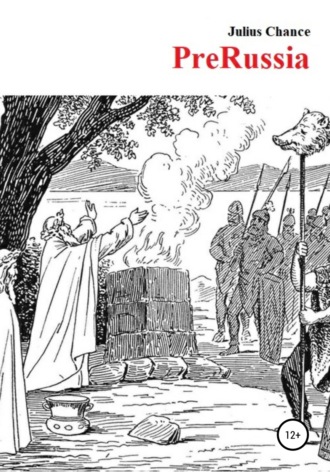
Julius Chance
PreRussia
And what does archaeology say?
It testifies that in fact the Varangians (Vikings) appeared on Russian soil long before the advent of Rurik starting from the VI century and in some places even before the Slavs (in the north of Ladoga, for instance).31 Some of them were in the service of Russian princes. Others mastered the way "from the Varangians to the Greeks" in order to profitably trade furs with rich Byzantium from the Scandinavian and Russian northern lands.32 To do this they built their support towns along this route from north to south.
The so-called Staraya Ladoga (Old Ladoga), the first capital of Russia, lies just along this path on the banks of the full-flowing Volkhov River near its confluence into the Ladoga Lake. The river flows from the great lake Ilmen near which a fortified Novgorod city appeared in 859 on the site of the former Novgorod settlements. Staraya Ladoga as a settlement was founded by Slavs around 700 and was agricaltural.33 As a city it was erected in 753 originally by the Varangians but a few years later Slavs it was recaptured by the Slavs.34

The image of the fortress "Staraya Ladoga" by Dionisius1976 (pseudonym) from https://pl.wikipedia.org under CC License.
Thus, the Russian Slavs had owned the city of Staraya Ladoga for more than a century and Novgorod had been built 3 years before the arrival of Rurik.
It should be noted that with the exception of the reconquest of Staraya Ladoga no serious conflicts were recorded between the local Slavs and the Scandinavian Varangians which further confirms the fact that the Vikings were present in Russia for a very long time and were already perceived as "our foreigners". Of course the Varangians (Vikings) themselves were primarily interested in peace so that they would not have to defend their transshipment towns and transports with blood all along the trade route "from the Varangians to the Greeks" (that would make this commercial project impossible). The idea of such a way was to sail on ships on rivers and drag ships between rivers. This route is drawn on the map below.

Map of the Varangian Routs (Varangianroutes.png) from the free repository commons.wikimedia.org under CC License.
Between the rivers the ships rolled on logs laid under them. Many later wondered where the equestrian Cossacks acquired such skills in dragging ships by land, especially during Yermak's campaign in Siberia. As we can see the Vikings where their teachers.
The real age of Russia
The fact that statehood arose in our country before the arrival of Rurik is confirmed by the Bertin Annals, which are recognized in the West as well. Thus, the age of Russia is indeed incorrectly determined, even by Western standards. Well, if so, let's list some other, especially non-Western foreign sources mentioning the Russian people, including Arabic and Byzantine ones. According to Anton Belyakov's 2018 study "The Keys to Russian History…" they are as follows: 35
I century. The famous Roman writer and politician Tacitus (lived from 50 to 120) mentions rugs (Rujans) on the southern shore of the Baltic.
II—III centuries. The Gothic historian Jordan (lived in the VI century) reports on the struggle of the Goths in the Baltic States with the Rugs.
Between 307 and 314 years. In the Verona Document (the list of Rome's allied countries obliged to supply troops for Rome's needs but retaining some political independence) the Rugsare named among the Roman federates.
Before 337. The Byzantine writer of the first half of the XIV century Nikephoros Gregorr mentions a Russian prince who held a court position under Emperor Constantine.
The second half of the IV century. The historian Jordan (lived in the VI century.) mentions the Rogs as part of the Germanic power and then speaks of the Rosomon tribe which broke out of obedience.
Between 379-395 years. Russian chronicle from the reign of Vladimir Svyatoslavich to Ivan IV inclusive) speaks about the "battle with Russian soldiers" of Emperor Theodosius troops. It also mentions the Russian attack on the Selunsky Grad.
434-435 years. The Rugs appear on the Sava River near the town of Novieduna (present-day Yugoslavia) where they come into collision with the Goths.
454 year. A part of the Rugs joins the Huns and together with them are defeated by the Gepids and the tribes acting on their side including most of the Rugs. The defeated retreat from the Danube to the Dnieper and the Black Sea and some of them retreat to the Adriatic coast.
469. The Rugs are defeated by the Goths in the struggle for Pannonia.
476 year. Odoacer (who is Rug according to the Gothic historian Jordan) the commander of a detachment of barbarian mercenaries in the Roman army (and later the king of Italy) as the head of an army consisting of Rugs, Skirrs and Turks overthrows the last emperor of the Western Roman Empire. He is called the Russian prince from the island of Rugen.
489 year. The Gothic King Theodoric opposes the Italian King Odoacer. There are rugs in both armies.
493 year. Theodoric treacherously kills Odoacer. The Rugs participate in the proclamation of Theodoric as King of Italy.
The middle of the VI century. The Rugi seize power in Italy for a while and raise their leader Erarich to the royal throne.
568 year. The Avars occupy Pannonia and the Lombards pass through the Slavic kingdom of Rugiland (in present-day Austria) to Northern Italy.
VI century. The Syrian author Pseudo-Saccharum mentions the Ros people in the Black Sea region.
VI century. As-Sa'alibi, the historian of the beginning of the XI century at the court of the Ghaznavids (now Southern Afghanistan) in the story about the construction of the Derbent Wall by Khosrow I (531-579) mentions the Russ along with the Turks and Khazars.
VI century. Zahir al-din Mar'ashi, the 15th-century Persian author from the Caspian region mentions the Russ in the North Caucasus region.
626 year. The Byzantine poet Konstantin Manassi (XII century) names the Russians among those who besieged Constantinople together with the Avars.
643 year. At-Tabari, the Arab historian from Baghdad (838-923) twice calls the Russ as enemies of the world, especially the Arabs.
765 (or 773) year. The Byzantine chronicler Theophano (died 817) mentions Russian helandiy (ships).
773-774 years. Russian Count Erno is mentioned in the French poem about Ogier the Dane (XII—XIII centuries) who led a Russian detachment defending Pavia (the capital of the Lombards) from the army of Charlemagne. In Northern Italy the Russ occupy the Garda area near Verona (the Scandinavians then called Eastern Russia "Guards").
Ca. 778. The famous heroic French poem of the Middle Ages "The Song of Roland" names the Russ among the opponents of the Frankish army. "Russian cloaks" are also mentioned.
The end of the VIII – beginning of the IX century. In the poem "Renaud de Montebane" (late XII – early XIII century) based on ancient folk tales a Russian count is named among the entourage of Charlemagne.
The end of the VIII century. In “The Life of Stefan Surozhsky” the Russian Prince Bravlin is mentioned. The name of the prince probably comes from Bravalla at which in 786 there a great battle took place between the Danes and the Frisians. The Frisians were defeated and many of them left their country moving to the east.
The end of the VIII century. "Geographer of Bavaria" in his list of peoples and tribes who inhabited the areas east of the Frankish state in the IX century (found in the Bavarian State Library, Munich) mentions the Russ located next to the Khazars as well as certain Ros (Rots) somewhere in the interfluve of the Elbe and Sala: Attoroses, Viliroses, Hoziroses, Zabroses.
VIII—IX centuries. Popes Leo III (795-816) and Benedict III (855-858) send special messages to the "clerics of the Rogs". Apparently, the Rug communities continued to keep apart from the rest of the Christians.
839 year. The Bertin Annals report the arrival of a representatives of the people of Ros whose ruler bore the title of Khagan to Louis I the Pious (in a company with the ambassadors of the Byzantine Emperor Theophilus).
Before 842. The description of the life of Saint and Bishop George of Amastrid tells about the attack of the Roses on the Byzantine city of Amastrida (Asia Minor).
Between 836-847. The outstanding scientist Muhammad ibn Musa al Khorezmi in a geographical composition mentions the Russian Mountain from which the river Drus originates.
844 year. The Arab historian from Khorezm Al-Yakubi reports on the Rus attack on Seville in Spain.
844 year. The head of the post offices of northern Persia and geographer Ibn Khordadbeh in his "Book of Ways and Countries" calls the Russ a kind of the Slavs.
June 18, 860. The attack of the Rosses on Constantinople is documented in the Byzantine chronicles.
861 year. The Byzantine Greek Konstantin-Kirill the Philosopher, the future creator of the Slavic alphabet (together with Methodius) discovers in the Crimea the gospel and the psalter written in Russian scripts, learned the spoken language and deciphered the writing (meeting with a person who spoke this language).
As we can see since the VI century (3 centuries before the arrival of Rurik) Russia in one form or another is constantly present in Arab, Byzantine and even Western European sources.
How many Russias were there?
As other researchers discovered, several Russ operated throughout Europe – from the Pyrenees to the Caucasus Mountains and from the Baltic coast to the Mediterranean coast. If we take into account all the evidences then at least 14 Rus states are known: as many as four Rus(es) were in the Baltic States. Rus also existed on the banks of the Dnieper, on the Don, at the mouth of the Danube, in the Carpathian Mountains, on the coast of the Azov and Caspian Seas, in the Crimea, in Western Europe (on the territory of modern Austria), in Thuringia, in Saxony, and even some Rus (Ruzzika) was part of the Vandal kingdom in North Africa.36
The question arises how many of these Rus states scattered all over the Earth were the fragments of a single Russian super-ethnos? How much were they related to each other? Which of them contributed and in which way to the creation of the Russian state of the Eastern Slavs? It is simply impossible to bring all this information, theories and hypotheses in one book. Therefore only the 3 most well-established and reasoned groups of theories (mentioned in the beginning) are outlined here.
The origin of Russia is such a topic where there are three opinions between two historians. There is a separate thick book dedicated to numerous inconsistencies in ancient Russian history where the author has dug up so many of them that in his opinion it's time to rewrite the entire history anew.37 As a matter of fact it is going to happen indeed as the now officially accepted Norman theory is very shaky under the blows of new and new pop-up facts.
Wars of Russia with Byzantium
Russia adopted the Orthodox faith from the Greeks through Byzantium. After the conquest of Byzantium by the Ottoman Turks, Russia considered itself to some extent its spiritual heir. Even during the time of the atheistic USSR some historians called Moscow the Third Rome (the second was Constantinople of Byzantium, later renamed to Istanbul). But it was later. Back then the relations of the growing Russian state with the decrepit Byzantine Empire were not always friendly:
A successful robbery raid by the "great Russian army" on the Crimean Byzantine city of Surozh (Sugdea) in 750 (according to other sources – in 790) led by Prince Bravlin from Novagrad.
Rus' campaign against Byzantium (830s). The Russ raided on the province of Paphlagonia during the reign of Emperor Theophilus. The Russ plundered the city of Amastrida and withdrew. Perhaps it was a revenge for the failure of the Russian embassy mission to Byzantium in 839 (because the consulate was not established).
The campaign of Russia against Byzantium in 860. Although Constantinople (Tsargrad) was not captured the Russ took away a large booty. Presumably the campaign was led by the Varangian Kievan princes Askold and Dir. According to “The Tale of Bygone Years” this campaign took place in 866 by a Russian chronology (which was 6 years ahead of the Byzantine one), that is two years after Rurik's arrival in Russia.
The Russian-Byzantine War of 907 – the legendary campaign against Constantinople by Prince Oleg. According to the "Tale of Bygone Years" it led to the signing of peace in 907 and was followed by the conclusion of a trade agreement beneficial for Russia in 911.
The Russian-Byzantine War of 941-944 – the campaigns against Constantinople by Prince Igor. In the first campaign the Rus army failed at sea, the second campaign ended with the signing of a peace treaty and a tribute from Byzantium.
The Russian-Byzantine War of 970-971 – the campaign of Prince Svyatoslav, first in alliance with the Greeks against Bulgaria and then in alliance with the Bulgarian tsar (king) Boris II against Byzantium. The war ended with the withdrawal of Russian troops from Bulgaria and the death of Svyatoslav at the hands of the Pechenegs.
The Russian-Byzantine War of 988 – the successfull siege of Korsun in the Crimea by Prince Vladimir. After that the gradual baptism of the Russian people followed.
The campaign of Russia against Byzantium in 1024 – an “independent” non-state campaign of a detachment of the Russ led by Chrysochyrus to the island of Lemnos during the time of troubles of the power struggle in Russia. All 800 participants of the campaign were killed.
The Russian-Byzantine War of 1043 – fleet attack (400 ships) to Constantinople (Tsargrad) led by Yaroslav the Wise. It ended in failure – some ships were lost to a storm, others were burned by «Greek fire».
These campaigns against Byzantium were aimed not only at extracting profit from robbery, trade or imposed tribute, but also the original desire of Russia to be a maritime power. Russia strived to get access to the sea and control the entire trade route "from the Varangians to the Greeks" – from the cold Baltic to warm Byzantium. However, we cannot exclude that these campaigns were carried out by several different "Russian" states.
Such campaigns taught the predecessors of the Cossacks the skills of making special small durable vessels that could sail both on the seas and rivers and be dragged by the ground, which later became so useful to them during the conquest of Siberia.






